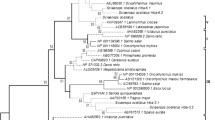Summary
Callianassa californiensis has two hemocyanins present in the blood, a 39 S form and a 17 S form. It does not regulate major blood ions with decreasing salinity, thus the ion levels can drop dramatically in winter when estuarine seawater becomes more dilute. Its hemocyanin shows remarkably little functional change when salinity is reduced from 35‰ to 17.5‰. At normal blood pH (∼ 8.2 at 10°C) the affinity decreases from 2.5 to 4.5 mm Hg with lowered salinity. The Bohr effect curves at both salinities have a complex biphasic shape with an average slope of −1.59, but they differ in affinity so they are parallel through the pH range 7.0 to 9.0. Cooperativity remains the same at every pH for the two Bohr series with maximumn H≅3.5 at physiological pH. There is no change in blood pH at low salinity. The 39 S and 17 S hemocyanins have similar affinities but the cooperative behavior is different. Adding NaCl and KCl to physiological levels slightly decreases affinity compared to MgCl2 and CaCl2 alone. Lowering temperature increases affinity.
Similar content being viewed by others
References
Arisaka F, Holde KE Van (1979) Allosteric properties and the association equilibria of hemocyanin fromCallianassa californiensis. J Mol Biol 134:41–73
Blair D, Holde KE Van (1976) Sedimentation equilibrium studies of a complex association reaction. Biophys Chem 5:165–170
Brouwer M, Bonaventura C, Bonaventura J (1977) Oxygen binding byLimulus polyphemus hemocyanin: Allosteric modulation by chloride ions. Biochemistry 16:3897–3902
Brouwer M, Bonaventura C, Bonaventura J (1978) Analysis of the effect of three different allosteric ligands on oxygen binding by hemocyanin of the shrimp,Penaeus setiferus. Biochemistry 17:2148–2154
Good NE, Winget GD, Winter W, Connolly TN, Izawa S, Singh RMM (1966) Hydrogen ion buffers for biological research. Biochemistry 5:457–477
Felder DL (1978) Osmotic and ionic regulation in several western Atlantic Callianassidae (Crustacea, Decapoda, Thalassinidea). Biol Bull 154:409–429
Holde KE Van, Blair D, Eldred N, Arisaka F (1977) Association equilibria ofCallianassa hemocyanin. In: Bannister JV (ed) Structure and function of haemocyanin. Springer, Berlin Heidelberg New York, pp 22–30
Long C (ed) (1961) Biochemists handbook. Van Nostrand, Princeton, p 28
Mangum CP (1976) The function of respiratory pigments in estuarine animals. In: Wiley M (ed) Estuarine processes, vol I. Academic Press, New York, pp 356–380
Mangum CP (1981a) The influence of inorganic ions and pH on HcO2 transport systems. In: Lamy J (ed) Invertebrate oxygen binding proteins. Dekker, New York, (in press)
Mangum CP (1981b) Oxygen transport in the blood. In: Mantel LH (ed) Biology of crustacea, vol II. Academic Press, New York (in press)
Mangum CP, Lykkeboe G (1979) The influence of inorganic ions and pH on oxygenation properties of the blood in the gastropod molluseBusycon canaliculatum. J Exp Zool 207:417–430
Mangum CP, Towle DW (1977) Physiological adaptation to unstable environments. Am Sci 65:67–75
Miller K, Holde KE Van (1974) Oxygen binding byCallianassa californiensis hemocyanin. Biochemistry 13:1668–1674
Miller KI, Pritchard AW, Rutledge PS (1976) Respiratory regulation and the role of the blood in the burrowing shrimpCallianassa californiensis (Decapoda: Thalassinidae). Mar Biol 36:233–242
Miller KI, Eldred NW, Arisaka F, Holde KE Van (1977) Structure and function of hemocyanin from thalassinid shrimp. J Comp Physiol 115:171–184
Pritchard AW, Eddy S (1979) Lactate formation inCallianassa californiensis andUpogebia pugettensis (Crustacea: Thalassinidae). Mar Biol 50:249–253
Roxby R, Miller K, Blair DP, Holde KE Van (1974) Subunits and association equilibria ofCallianassa californiensis hemocyanin. Biochemistry 13:1662–1668
Thompson LC, Pritchard AW (1969) Osmoregulatory capacities ofCallianassa andUpogebia (Crustacea: Thalassinidea). Biol Bull 136:114–129
Thompson RK, Pritchard AW (1969) Respiratory adapatation of two burrowing crustaceans,Callianassa californiensis andUpogebia pugettensis (Decapoda: Thalassinidea). Biol Bull 136:274–287
Thum AB (1972) An ecological study ofDiatomovora amoena, an interstitial Acoel flatworm, in an estuarine mudflat on the central coast of Oregon. Ph D thesis, Oregon State University
Truchot J-P (1975) Factors controlling thein vitro andin vivo oxygen affinity of the hemocyanin in the crabCarcinus maenas (L.) Respir Physiol 24:173–187
Weiland AL, Mangum CP (1975) The influence of environmental salinity on hemocyanin function in the blue crab,Callinectes sapidus. J Exp Zool 193:265–273
Author information
Authors and Affiliations
Rights and permissions
About this article
Cite this article
Miller, K.I., Van Holde, K.E. The effect of environmental variables on the structure and function of hemocyanin fromCallianassa californiensis . J Comp Physiol B 143, 253–260 (1981). https://doi.org/10.1007/BF00797705
Accepted:
Issue Date:
DOI: https://doi.org/10.1007/BF00797705



